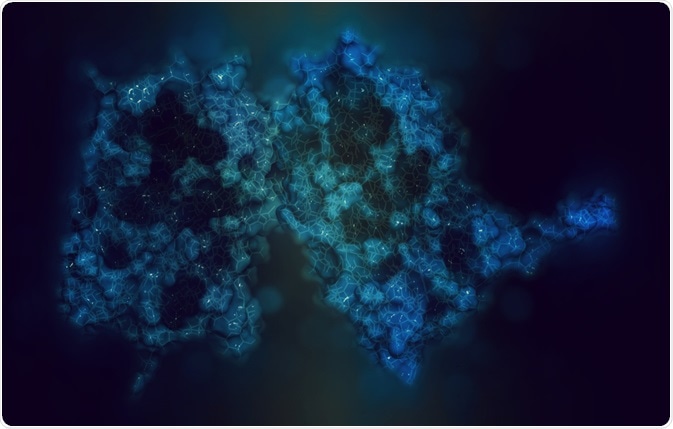Viruses are widespread and even with modern medicine, they remain one of the main causes of human disease. This has been recently illustrated by the SARS-CoV-2 (COVID-19) pandemic but other common examples are HIV, herpes, and the common cold. For this reason, medicines that target viruses are vital.

Image Credit: StudioMolekuul/Shutterstock.com
Antimicrobial peptides have shown some effectiveness as broad range antivirals but they lack specificity and low-efficiency antiviral treatments lead to rising levels of viral resistance. Designer antiviral peptides represent a class of antivirals that are rationally designed for each virus increasing specificity.
How Antivirals Work
A viral infection is very different from a bacterial one. A virus cannot replicate by itself therefore to reproduce it hijacks host cells and uses their cellular machinery to manufacture more viral particles. Different antiviral drugs target different elements of this process thereby inhibiting the life cycle of the virus.
An antiviral can either target the host cells or the virus itself, but specificity is a major consideration otherwise there are considerable off-target effects. Antivirals can target the host cells and inhibit the cellular factors that a virus harnesses to hijack the cell. Alternatively, they can target the virus, targeting viral replication and transcription enzymes or receptors on the viral cell surface.
Peptides can be used as antivirals. They are short chains of amino acids that are distinguished from proteins due to their shorter length. Most antiviral peptides are virucidal, they work through inhibiting the virus rather than on the host cells. They do this either through direct inhibition of the virus or through competitively binding the receptors responsible for fusion with the host cells thereby preventing the virus from entering the cell.
Designing Antiviral Peptides
There are many natural sources for peptides including plants, marine organisms, or mammals which are screened for antiviral properties. However, designer antiviral peptides are created through template-based design, physicochemical, or de novo methods. They are rationally designed then screened against the viral targets.
The template-based design takes known peptides and replaces or relocates amino acids to increase the desired properties of selectivity or activity. This method can even be used to reduce the size of the peptide or create an active peptide from an inactive one. This is similar to the physicochemical design of antiviral peptides where a known peptide sequence is adapted, changing the physiochemical properties and enhancing activity. The final method is the de novo method. This method creates entirely new peptides relying on amino acid frequencies, patterns, or algorithmic design.
Designing an antiviral peptide relies on a greater understanding of the target virus than using a naturally occurring peptide. Therefore, knowledge of the virus is essential, which is why many of the designer antiviral peptides target the glycoproteins on the viral envelope. These are the proteins that are used to enter host cells, making a highly conserved sequence. This also provides the added benefit of specificity, as each peptide is designed for a particular virus.
SARS-CoV-2 and Antiviral Peptides
SARS-CoV-2 (COVID-19) is a contagious virus that attacks the lungs and airways. Since it was identified in 2019 many different treatments, including vaccines, are being urgently researched. These new treatments include designer antiviral peptides.
An appealing target for these peptides is the highly conserved spike protein on the viral envelope. This spike glycoprotein binds ACE2 receptors of host cells initiating fusion. These designer peptides can target the spike protein of the virus preventing it from binding to ACE2 or by competitively binding to the ACE2 receptor on the host cell’s surface thus preventing the spike protein from binding. 14 peptide derivates of the spike protein have already been screened for this competitive binding.
Another target for antiviral peptides is the viral proteases papain-like protease and 3C-like protease. These proteases are essential in SARS-CoV-2 viral replication and transcription. They work by breaking down the two polyproteins into the necessary viral proteins for these processes.
Through screening of peptide substrates for the target proteases to identify potential antivirals, then modifying them to be inhibitory through the addition of an irreversible reactive group at the C-terminus, these peptides were shown to kinetically inhibit the proteases.
These two targets of the SARS-CoV-2 virus demonstrates the versatility of designer antiviral peptides. They tackle very different processes of viral infection and the use of designer antiviral peptides has even been suggested as a possible source for a SARS-CoV-2 vaccine.

Image Credit: narci5/Shutterstock.com
Summary
Designer antiviral peptides are vital in the search for much-needed antivirals, they provide a method of accurately targeting specific viruses. The process of designing these peptides ranges from modifying natural peptides to rationally design with algorithms. Designing antiviral peptides relies on a solid understanding of the structure and function of the virus in question.
Although antiviral peptides frequently target the glycoproteins on the viral envelope as these are highly conserved as illustrated by the example of SARS-CoV-2 they can also be used to target the viral replication and transcription processes. This highlights the potential for the use of designer antiviral peptides in the fight against viral infections.
References
- Al-Azzam, S., Ding, Y., Liu, J., Pandya, P., Ting, J. P., & Afshar, S. (2020). Peptides to combat viral infectious diseases. Peptides, 134, 170402. https://doi.org/10.1016/j.peptides.2020.170402
- Ling, R., Dai, Y., Huang, B., Huang, W., Yu, J., Lu, X., & Jiang, Y. (2020). In silico design of antiviral peptides targeting the spike protein of SARS-CoV-2. Peptides, 130(March), 170328. https://doi.org/10.1016/j.peptides.2020.170328
- Silva, L. R., da Silva Santos-Júnior, P. F., de Andrade Brandão, J., Anderson, L., Bassi, Ê. J., Xavier de Araújo-Júnior, J., Cardoso, S. H., & da Silva-Júnior, E. F. (2020). Druggable targets from coronaviruses for designing new antiviral drugs. Bioorganic and Medicinal Chemistry, 28(22), 115745. https://doi.org/10.1016/j.bmc.2020.115745
- Vilas Boas, L. C. P., Campos, M. L., Berlanda, R. L. A., de Carvalho Neves, N., & Franco, O. L. (2019). Antiviral peptides as promising therapeutic drugs. Cellular and Molecular Life Sciences, 76(18), 3525–3542. https://doi.org/10.1007/s00018-019-03138-w
Further Reading